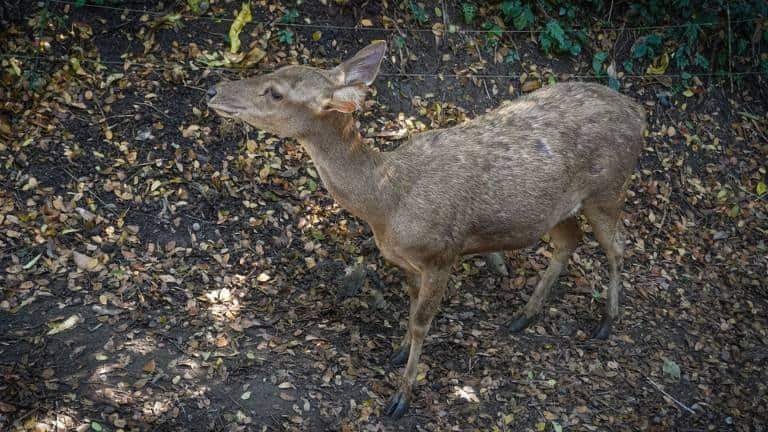The terrain might not be the deciding factor; rather, it’s the vegetation that attracts these animals. Axis deer, akin to grazers like sheep, prefer grass and low-lying plants found in specific areas. On the other hand, Whitetail deer, behaving more like goats, opt for leaves and bushes, explaining their presence in brushier regions.
Observationally, axis deer exhibit impressive agility in traversing rocky hills, potentially even outperforming whitetails. Examining the hooves of a sizable axis buck reveals they are about half the size of a whitetail’s, indicating adaptation to rocky terrains. A compelling case in point is the thriving axis herds in Tappitillo Springs, known for its challenging topography. Despite the rugged terrain, the axis population remains well-nourished, thanks to the conscientious efforts of the local homeowners. Let’s have a look on how to attract axis deer like a pro deer hunter.
How to attract Axis Deer
Axis deer have gained popularity as exotic game animals, offering a challenging hunt for experienced hunters. If you’re aiming to add an axis deer to your trophy collection, here’s a guide on how to attract them to your property:
1. Make a Food Plot
Axis deer are browsers, favoring leaves, twigs, and plant material over grass. Establish a food plot with plants they prefer, such as clover, alfalfa, lespedeza, and chicory. You can also use corn but I recommend you use alfalfa in big amounts because that’s what always worked for me.
2. Provide Cover for them
Apart from food, axis deer require cover from predators and the elements. Plant trees and shrubs like live oak, cedar, mesquite, and hackberry to offer dense cover. This will help to attract axis deer to your property.
3. Make a Water Source Available
Ensure access to water by incorporating a small pond or water hole on your property. They’ll also drink from puddles, making this a viable option in rainy regions.
4. Use Deer Attractants
Employ deer attractants containing scents or tastes that appeal to deer. Experiment with different types to find what works best for attracting axis deer to your desired area.
5. Be Patient
Adjusting to a new environment takes time for axis deer. Whether you’ve created a food plot or water source, be patient. It might take weeks or months before deer start using it regularly. Maintain your property well, and the deer will eventually come.
By following these steps, you can successfully attract axis deer to your property. Once they’ve settled in, you can plan your hunt. With preparation and patience, you’ll soon be able to proudly add an axis deer to your trophy collection.
Understanding Axis Deer Behavior
Understanding the dynamics in our area took me a few years, but now I’ve got a handle on it. During this time of year, coaxing deer toward a corn feeder or alfalfa becomes quite challenging due to the abundance of fresh grass. They tend to roam the lower regions of our ranch, grazing along the way. Despite having stands in high points, they effortlessly navigate the higher and rougher terrains. In the evenings, especially when they start moving, I consistently spot them in the low cuts and creeks.
In the off-season, protein feed works wonders. It’s surprising how many deer gather around a protein feeder in the evenings. Interestingly, the morning doesn’t seem to entice axis deer as much. I suspect their nocturnal feeding habits during hot nights lead them to skip morning feeds. Water sources are key during this time of year, and the hotter it gets, the more successful I am at harvesting axis.
Come late winter, corn and alfalfa feeders become irresistible to them. Even the most cautious ones can’t resist. Axis deer on our lease make whitetails seem less savvy. They exhibit more movement at sunup during winter months, but, in general, axis tend to move later than whitetails. I’ve found that encounters and successful hunts are more likely during mid-morning—they seem to keep “bankers’ hours.”
Understanding Axis Deer’s behavior throughout each season will make your hunting much easier.
What is the best time to hunt axis deer?
Axis deer are seen to be the ideal deer in nature because of their enormous antlers, gorgeous skin, and the greatest meat available. They present just as much of a challenge as any other game animal worldwide. As axis deer are tropical in nature and do go into estrus all year round, they are atypical among other deer species in that they have hard horns.
The best time to hunt them though is during the late spring through summer months. Typically, the rut peaks in June and July. These bucks have incredibly long tines and are broad, as you will observe. Unlike whitetail deer, axis deer congregate in groups, and during the rut, you will almost always locate a dominant buck among them. Axis deer rarely allow you much opportunity to observe them while they’re not rutting.
Where to find Axis Deer?
Axis deer are nocturnal, shy creatures who have a reputation for being proficient swimmers. Their magnificent antlers make them an exquisite prize for any hunter, and they are also renowned for being difficult and gratifying to hunt.
Axis deer are a little trickier to hunt than typical deer, but you may still succeed if you put in a little planning and research. It’s critical to understand their lifestyle and routines. You may begin organizing your quest as soon as you get this knowledge.
The most typical places to find them are forested locations with lots of shelter. They also gravitate toward densely vegetated regions, so your chances of seeing one may be higher if you’re hunting in a densely vegetated area.
Conclusion
In conclusion, understanding the behavior and preferences of axis deer is crucial for a successful hunting experience. This article highlights the significance of vegetation over terrain in attracting these exotic game animals. The advice provided, from creating a suitable food plot to ensuring adequate cover and water sources, offers a comprehensive guide for hunters looking to add an axis deer to their trophy collection.
The additional insights into axis deer behavior throughout the seasons, the best times to hunt them, and where to find them further enhance the reader’s understanding. Patience is emphasized as a key virtue in attracting axis deer to a new environment.
By following the outlined steps and considering the nuances of axis deer behavior, hunters can increase their chances of a rewarding and successful hunt. Whether it’s the challenge of coaxing them into a corn feeder or understanding their habits during different seasons, this article aims to equip hunters with valuable knowledge for a more enjoyable and fruitful hunting experience.

